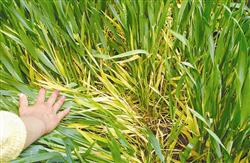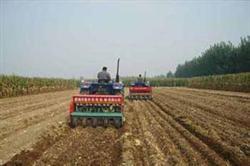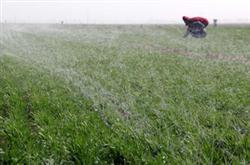Prevention and control of diseases and insect pests of wheat in spring

Spring is not only a critical period for wheat growth, but also a period of frequent occurrence of diseases and insect pests, so the management of wheat spring season pays attention to the prevention and control of diseases and insect pests the following introduces several common wheat diseases and insect pests in spring and their control methods: wheat rust and powdery mildew: in areas where the disease is serious, it is necessary to apply medicine in time to control the spread, using 40-50 grams of 15% strychnine per mu and adding 10-12 kilograms of water. Apply the medicine with a motorized sprayer, including the wheat leaves within 2-4 meters around. If the spray is late, the dosage can be increased to 60-70 grams per mu. Wheat scab: after the onset of disease to surprise control, per mu with 80% carbendazim powder 25 grams, or 40% carbendazim gel suspension 50 grams, in the flowering period can be injected once, in case of continuous rain can be injected again. Wheat aphid: the number of wheat aphids per 100 ears is more than 500, and when the ratio of beneficial insects to wheat aphids exceeds 1: 100, 10% imidacloprid per mu and 10 kg of water spray are harmless to natural enemies. You can also use 40% omethoate, 30 ml per mu plus 10 kg of water spray. Wheat spiders: wheat spiders often live near wheat roots during the day and can be drowned by watering after 9 o'clock in the afternoon. When investigating more than 200 wheat spiders in 33 cm double rows, there could be 80% dichlorvos, 10 20 ml per mu plus 10 kg of water spray. Can also be used to clean acarides, red and white mites and other acaricidal pesticides with water spray. Wheat trematode: trematodes usually live in the soil and harm wheat ears for a short time. In late April, 50% phoxim or 40% methyl ethyl parathion can be mixed into arsenopyrite with 250 grams per mu, and the control effect can reach about 90%.
- Prev

Control techniques of Red Spider in Winter and Spring Wheat
The key to a bumper grain harvest is to improve the quality of sowing with seven-minute planting and three-part management. At present, spring wheat in our province is about to enter the sowing period, how to make a good sowing pass and improve the sowing quality is related to the overall situation of spring wheat harvest throughout the year. First, the selection of improved varieties to win high wheat yield, soil is the foundation, fertilizer is nutrition, water is the lifeline.
- Next

Wheat skillfully prevents lodging in spring
Watering fertilizer and water for jointing and topdressing nitrogen fertilizer at jointing stage can not only significantly increase protein content, but also be the key period to increase wheat yield. Therefore, fertilizer and water for jointing should be well used according to local conditions. The grain yield and protein content of wheat depend to a large extent on the level of nitrogen supply during the development period.
Related
- The first cup of black tea in spring, the flavor and history of tea gardens in Kenya, Africa
- The computer can not only choose potatoes, but also grow tea rice. AI will grow winter oolong tea champion.
- It is not only the inflated tea bitten by insects, but also engraved with the four seasons tea in Beipu.
- The Oriental Beauty Tea Festival in Zhuxian County takes the stage at the weekend to experience the plus-size feast of oil tea.
- & quot; Oriental Beauty Tea & Exploration of Emei in Hsinchu, the hometown of quot;
- The new variety of strawberry "Tainong 1" dessert is the first choice with mellow aroma. Crimson gorgeous
- History of Tea in Taiwan: from Wild Inner Mountain to Export Tea Garden
- Two types of Taiwan Oriental Beauty Black Tea won the British three-Star Award for Childhood Tea Xiang Zhang Jiaqi changed from pilot to champion tea maker.
- Banana species and varieties: the planting history of Taiwan Xianren banana and dwarf banana is long, is banana disease resistant?
- Coffee planting Technology: Qianjie Coffee from Seedling to harvesting

